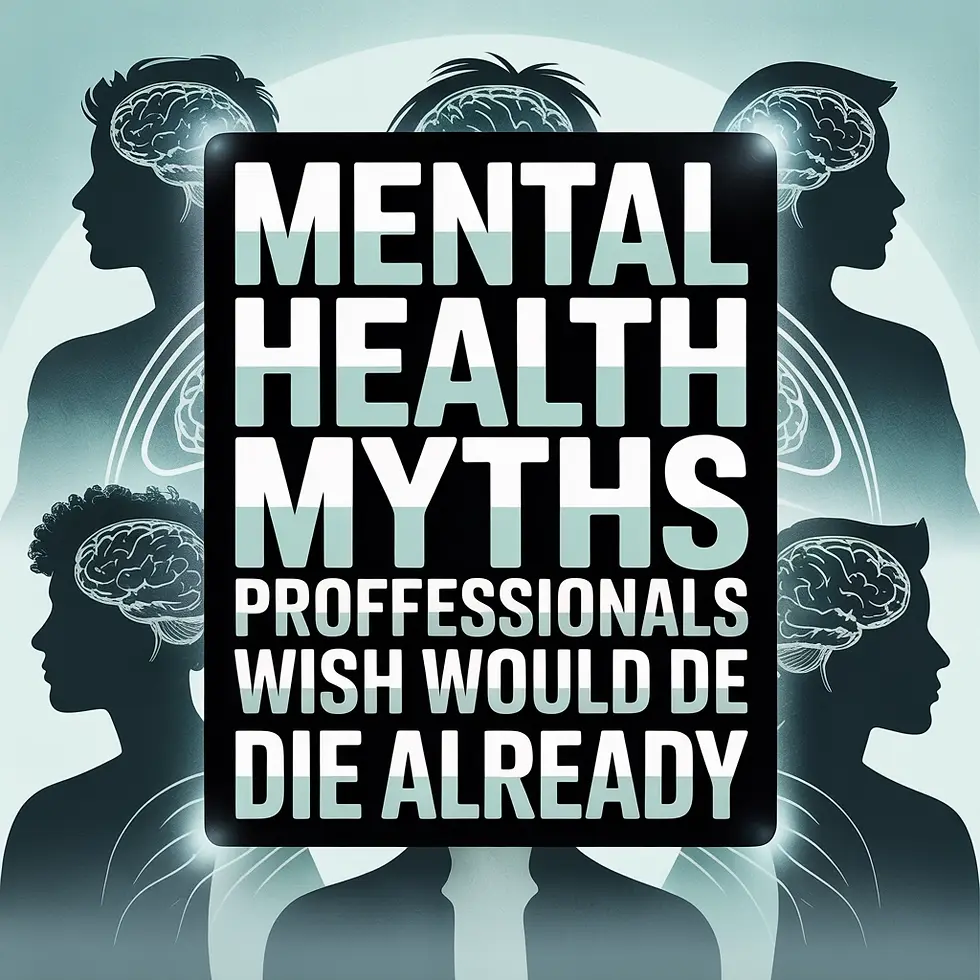The Therapist Mask: Being Real Without Oversharing
- Jul 21
- 6 min read

Walking the Line Between "Genuine Human" and "Emotional Oversharer"
Picture this: You're sitting across from your client, nodding thoughtfully as they share their deepest struggles. Meanwhile, your cat just threw up on your favorite rug, your partner texted that they're "done with this relationship" (they meant the Netflix series you were watching), and you're secretly wondering if that lunch you ate was actually expired. But there you sit, composed and professional, the picture of therapeutic serenity.
Welcome to the therapist's tightrope walk – balancing genuine human connection with appropriate professional boundaries. It's like being asked to simultaneously be completely authentic while also not traumatizing everyone with the unfiltered contents of your mind. No pressure!
Why This Balance Actually Matters
Gone are the days of the detached therapist who silently scribbles in a notebook. Research consistently shows that the therapeutic alliance – that magical connection between therapist and client – accounts for roughly 30% of therapeutic outcomes. So yes, connection matters. But so does not making the session about your ex, your knee pain, or your existential crisis about whether to start a therapy Instagram.
As one therapist in our Mental Health Mingle community recently shared: "Year one I was a therapy robot, year two I emotionally downloaded on everyone, and now I live in the magical land of ‘maybe don’t say that out loud.’"
How Oversharing Happens (Even When You Swore You Wouldn't)
Why do we sometimes cross that line into TMI territory? Several reasons:
The intimacy illusion: It feels like connection, but if it’s one-sided, it's just awkward.
Empathy on overdrive: "My client is sharing so much; I should reciprocate to normalize their experience!" You want to say, "OMG SAME," but this isn’t brunch.
Authenticity pressure: In a world where "being real" is currency, wearing any kind of professional mask can feel fake.
Blurred lines: Especially when clients feel a little like friends or you’ve lived through similar trauma.
A therapist once told us: “I realized I overshared when my client stopped crying to ask if I was okay.”

The Self-Disclosure Sanity Check
Not all self-disclosure is created equal. Here's a handy framework for deciding when sharing serves the therapeutic relationship:
Before you get vulnerable, ask:
Who benefits from this disclosure? (Hint: If it's mainly you, stop there)
Is this brief or am I about to launch into a TED talk?
Does this illuminate something about the client's experience or just shift focus to me?
Have I processed this enough to share it without emotional leakage?
Would I be comfortable if my supervisor heard me share this?
Types of Helpful Disclosure:
Process disclosure: "I notice I'm feeling confused by what you just shared."
Here-and-now reactions: "I'm feeling a sense of sadness as you tell this story."
Normalizing experiences: Brief examples that help clients feel less alone.
Professional disclosure: Sharing your approach, philosophy, or training.
Red Flag Disclosures:
Unresolved trauma
Current crises
Detailed personal stories
Political rants (unless directly relevant to client goals)
Anything that makes the client feel they need to take care of you
Being Real Without Turning Into a Reality Show
Authenticity doesn’t mean telling your client your childhood nickname or your thoughts on the finale of The Bachelor. It means showing up with your actual self - your humor, your values, your presence - while keeping the focus on them.
Pro Tips:
1. The 3-Second Pause
Pause and assess before sharing. If you’re still unsure, don’t.
2. Develop Stock Responses
When clients ask personal stuff, have ready responses that feel authentic but don't cross boundaries. For example:
When clients ask if you've experienced trauma: "I believe we all have difficult experiences that shape us. What would it mean for you if I had experienced something similar?"
When clients ask about your personal life: "I appreciate your interest in me as a person. I tend to keep my personal life separate to ensure our time stays focused on you. But I'm curious, what are you hoping to learn from that?"
3. The "Would I Share This at a Professional Conference?" Test
Would you say it on a panel of colleagues? If not, maybe keep it in the vault.

When the Mask Gets Too Heavy
Sometimes maintaining appropriate boundaries feels exhausting. Especially during personal struggles. Signs the mask is getting too heavy:
Feeling resentful about not being able to "be yourself"
Fantasizing about telling clients your problems
Increased slips in professional boundaries
Feeling isolated or misunderstood
...you might need to take that mask off somewhere safe.
One MHM member said it best: “My consult group is where I get to be a hot mess. I need that hour to survive the rest of my week.”
Case Study: The Overshare That Backfired
Meet Maya (not her real name), a therapist who struggled with the authenticity balance early in her career:
"I was working with a client processing grief after losing her mother. Having lost my own mother the year before, I felt incredibly connected to her experience. In my desire to help her feel less alone, I shared details about my mother's death and my grief process. I thought I was being helpfully authentic.
What actually happened? The session shifted to her comforting ME. She started editing her grief to protect my feelings. Our roles reversed, and her therapy stalled for weeks until we addressed the boundary crossing.
I learned that I could have simply said, 'I have some personal experience with grief that informs my work in this area,' and left it at that. The connection would have been made without the role reversal."
Define Your Boundaries Before You Test Them
The sweet spot between rigid professionalism and oversharing looks different for every therapist. Some naturally incorporate more humor and personality, while others maintain more traditional boundaries. Neither approach is inherently better. What matters is intentionality and client benefit.
Consider creating a personal self-disclosure policy that reflects:
Your approach (CBT vs. relational vs. improv comedy)
Who you serve (kids? trauma survivors? fellow therapists?)
Your personal comfort level
The ethical guardrails you follow
Most importantly, regularly revisit and adjust this policy through supervision, consultation, and self-reflection.

Community Support: Take the Mask Off With Us
Finding this balance isn't something you need to figure out alone. At Mental Health Mingle, our community of mental health professionals regularly discusses these nuanced professional boundaries in our peer support groups and professional development courses.
As one member recently shared: "Having a safe space to process these boundary questions with other therapists has been invaluable. I can workshop challenging scenarios before they become ethical issues."
The Bottom Line: Authenticity with Boundaries
Being a genuinely authentic therapist doesn't require sharing your life story. It requires:
Being honest about your expertise and limitations
Showing up with real empathy and presence
Maintaining appropriate boundaries that serve the therapeutic process
Bringing your unique personality and style to the work
Saving your personal processing for supervision, therapy, and peer support
Remember that clients don't need your self-disclosure to feel connected, they need your genuine presence, attunement, and focus on their needs.
As Carl Rogers himself might have said (if he had a slightly sarcastic streak): "Unconditional positive regard doesn't mean unconditional personal revelations."
Your authenticity as a therapist isn't measured by how much you share about yourself, but by how genuinely present you are for your clients. The most authentic thing you can do is maintain the boundaries that make effective therapy possible.
What's your experience with the authenticity balance in therapeutic relationships? Join the conversation at Mental Health Mingle where we support mental health professionals in navigating these complex professional challenges.




Comments